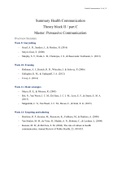Summary
Summary Health Communication: theory exam II / part C
- Course
- Institution
Summary that includes all material for the exam of Health Communication. The summary is built up through the structure of the articles, supplemented by the most important parts from the micro lectures and reading questions.
[Show more]



